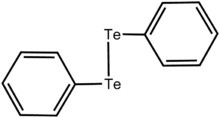Diphenyl ditelluride
Appearance

| |

| |
| Names | |
|---|---|
| IUPAC name
Diphenylditelluride
| |
| Other names
Phenylditelluride
| |
| Identifiers | |
3D model (JSmol)
|
|
| ChemSpider | |
| ECHA InfoCard | 100.046.332 |
PubChem CID
|
|
CompTox Dashboard (EPA)
|
|
| |
| |
| Properties | |
| C12H10Te2 | |
| Molar mass | 409.42 g/mol |
| Appearance | Orange powder |
| Density | 2.23 g/cm3 |
| Melting point | 66 to 67 °C (151 to 153 °F; 339 to 340 K) |
| Boiling point | decomposes |
| Insoluble | |
| Solubility in other solvents | Dichloromethane |
| Structure | |
| 90° at Se C2 symmetry | |
| 0 D | |
| Hazards | |
| Occupational safety and health (OHS/OSH): | |
Main hazards
|
Toxic |
| Related compounds | |
Related compounds
|
Ph2S2, Ph2Se2 |
Except where otherwise noted, data are given for materials in their standard state (at 25 °C [77 °F], 100 kPa).
| |
Diphenylditelluride is the chemical compound with the formula (C6H5Te)2, abbreviated Ph2Te2 This orange-coloured solid is the oxidized derivative of the unstable benzenetellurol, PhTeH. Ph2Te2 is used as a source of the PhTe unit in organic synthesis[citation needed] and as a catalyst for redox reactions.[1]
Preparation
Ph2Te2 is prepared by the oxidation of tellurophenolate, which is generated via the Grignard reagent:[2]
- PhMgBr + Te → PhTeMgBr
- 2PhTeMgBr + 0.5 O2 + H2O → Ph2Te2 + 2 MgBr(OH)
The molecule has C2 symmetry.
References
- ^ Alberto, Eduardo E.; Muller, Lisa M.; Detty, Michael R. (2014). "Rate Accelerations of Bromination Reactions with NaBr and H2O2 via the Addition of Catalytic Quantities of Diaryl Ditellurides". Organometallics. 33 (19): 5571–5581. doi:10.1021/om500883f.
- ^ Crich, D.; Yao, Q. "Diphenyl Ditelluride" in Encyclopedia of Reagents for Organic Synthesis (Ed: L. Paquette) 2004, J. Wiley & Sons, New York. doi:10.1002/047084289X.rd416.
